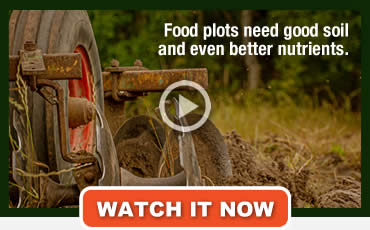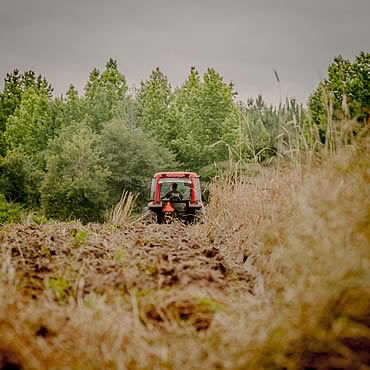Food plots need good soil and even better nutrients. These are necessities for growth. Crafting the perfect plot takes time. Simply cultivating soil and throwing out seed is not enough to lure in the perfect buck. Plots require science, which serves as the recipe for an ideal hunting experience.
Soil Basics
To get started from the ground up, every land manager should begin with the soil. In one handful of healthy soil, there are billions of living microorganisms. In fact, the same handful of soil contains more microorganisms than there are people on Earth. Their primary function is taking nutrients in soil that are not in plant-available form and turning them into a plant-available form.
The element carbon is the main food source for these creatures–food for the soil if you will. It is also the main element that comprises all livings things. There is a visible difference between soil that is rich in carbon and soil that is not. The darker the soil, the more organic matter it contains–allowing more nutrients and water retention potential.
Investing in Soils
Alabama Cooperative Extension System Soil Nutrient Management Specialist Rishi Prasad said it is important for everyone to invest in their soils.
"Everyone should learn about their own present soil health and nutrients by first learning about soil itself," Prasad said. "There are practical exercises–such as grid sampling, soil testing, variable rate nutrient application and manure application–that open the door to learning the art of soil nutrient management."
Perhaps the quickest and easiest way to begin managing a food plot is to first conduct a soil test with the Auburn University Soil, Forage and Water Testing Laboratory. This analysis provides a snapshot of the nutrients your soil lacks, as well as an acidity reading using the pH scale.
Submitted samples are also analyzed for phosphorus, potassium, magnesium and calcium. Based on the lab test results, fertilizer recommendations are sent to the customer within one to two days. Visit the Auburn University Soil, Forage & Water Testing Laboratory website for information and forms for any testing.
 Nutrient Breakdown
Nutrient Breakdown
• Nitrogen
Known as the growth element, nitrogen is responsible for increased plant growth more than all other nutrients. It can be found in every living cell, and it assists with regeneration and photosynthesis in plants. It is the first of three listed numbers on all bags or boxes of fertilizer.
Depending on the wildlife forage of choice, more nitrogen may need to be applied. For example, legume crops such as clovers do not require much nitrogen because they convert nitrogen from air and deposit it in the soil after decomposition. Always apply fertilizers according to soil test recommendations.
On the other side of the equation, heavy nitrogen users—including corn—will require more nitrogen application per acre than other forages. When planting corn, apply a second round of nitrogen after germination. When the proper amount of nitrogen is present in soil, wildlife forages will increase growth and yield higher protein levels—providing a nutritious resource for deer and other wildlife.
• Phosphorous
The second number on a bag of fertilizer, phosphorous, is known for promoting plant root establishment. Much like nitrogen, this element helps with photosynthesis. For deer, phosphorus is essential for antler and teeth growth.
Plants appear purple or red in color when they are deficient in phosphorus. As with all crop species, there is a specific requirement for phosphorus. It is important to fertilize in line with soil test recommendations.
• Potassium
Potassium, the final number of the fertilizer trilogy, plays an important role in root growth. Adding stem strength and vigor, potassium contributes some of the same benefits as it does with animals and humans. It is essential for wildlife nerve and muscle function.
Some cues to look for of potassium deficiency include scorched leaf margins and reduced plant vigor. When combined with nitrogen and phosphorus, this element completes the primary supplements for soil and plant health.
Understanding Soil Alkalinity
According to Norm Haley, Alabama Extension forestry and wildlife regional agent, understanding soil pH is one of the most overlooked aspects of soil health. Using the pH scale (see figure 2) from 1 to 14, a reading of 7 is considered neutral. Anything greater than 7 is considered more basic or alkaline. Respectively, any reading less than 7 becomes progressively acidic.
"When soil pH is low, or acidic, many nutrients become less available to plants, so fertilizing has less of an effect and can be a waste of money and time," Haley said. "By raising the pH to the optimal range of 6.0 to 6.5 for most food plot crops, growth may improve even without fertilizer applications while subsequent fertilizer applications will increase growth and yield because those nutrients are made more available for plant uptake."
 The Solution
The Solution
To increase pH, ground limestone is spread and often disked into the soil. Quarried lime is most likely in the form of calcitic lime (CaCO3) or dolomitic lime (CaMg(CO3)2). The granule size of the liming material also influences its neutralizing speed. The smaller the particle, the faster it will infiltrate the soil and change the pH.
"Wildlife managers may have difficulty obtaining a retailer to spread lime because they usually are planting low-acreage areas as compared to large production-scale farms," Haley said. "They often are placed at the bottom of the list as larger acreages take precedence. In this case, lime can be delivered, and buggies can be rented to spread the lime with a hydraulic system tractor. Small chain-driven or drop spreaders (with capacities of 1 ton or less) can be pulled behind an ATV, but loading and distributing lime this way can take a great deal of time and effort. However, this may be the only option for small or remote plots."
For wildlife managers tending to remote food plots, pelletized lime is sometimes recommended by vendors because of its ability to be spread with garden spreaders and electric hitch spreaders. Haley said that this type of granule has the potential to react quicker than other limestone types, but it comes with a price. Pelletized lime is sold at approximately $4 for a 40-pound bag—the equivalent of $200 per ton.
Contact Extension
The Alabama Cooperative Extension System takes the expertise of Auburn University and Alabama A&M University to the people. Our educators in all 67 counties are environmental partners - bringing practical ways to better our homes, farms, people and the world around us. Our research extends knowledge and improves lives.
Want to learn more about soil nutrient management and food plots? Visit www.aces.edu for more information.
Read Recent Articles:
• Get Bit! You haven't fished until you've done it bare-handed!
• Choosing the Right Backyard Target: Is there a better way to spend quality family time in the outdoors than slinging a few arrows in the backyard?
Subscribe today to have Buckmasters delivered to your home.